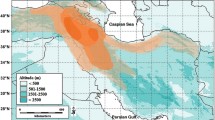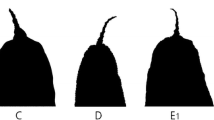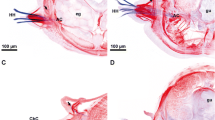Abstract
At least four hypotheses regarding the phylogenetic relationships within the Galaginae have been proposed, based on features of karyology, morphology, and behaviour, but these hypotheses share few common elements. Here we investigate erythrocytic allozymes as potential phylogenetic markers, and subject our results to a cladistic analysis. Our study offers little support for the previous models, but suggests instead that the greater galagos andG. alleni form a clade since they share character states for eight of the ten systems examined. The two lesser galago species could not be distinguished using these enzymes, and character states common to them and theallenicrassicaudatus-garnettii clade were found in only four systems. Our resultant cladogram accords well with the rather scant galagine fossil record. The data also show strong concordance with results obtained using highly repeated DNA sequences, which indicate that the galagos form a close-knit genetic group, while the Malagasy lemurids show considerably more inter-taxic variation.
Similar content being viewed by others
References
Arnaud, J., B. Meier, J. M. Dugoujon, &Y. Rumpler, 1992. Study of the variability of erythrocyte enzymes in captive and wild populations of the black lemur (Eulemur macaco macaco): an indispensable preliminary in captive breeding programmes.Primates, 33: 139–146.
Barnicot, N. A. &D. Hewett-Emmett, 1974. Electrophoretic studies on prosimian blood proteins. In:Prosimian Biology,R. D. Martin,G. A. Doyle, &A. C. Walker (eds.), Duckworth, London, pp. 891–902.
————,C. Jolly, E. R. Huehns, &J. Moor-Jankowski, 1964. A carbonic anhydrase variant in the baboon.Nature, 202: 198–199.
Barroso, C. M. L., M. P. C. Schneider, M. I. C. Sampaio, &F. M. Salzano, 1990. Esterase D in BrazilianSaguinus midas niger — results and comparison with previous studies in Anthropoidea.Amer. J. Primatol., 22: 215–219.
Buettner-Janusch, J. &V. Buettner-Janusch, 1963. Haemoglobins ofGalago crassicaudatus.Nature, 197: 1018–1019.
———— & ————, 1964. Hemoglobins of Primates. In:Evolutionary and Genetic Biology of Primates,J. Buettner-Janusch (ed.), Academic Press, New York, pp. 75–90.
———— & ————, & D. Coppenhaver, 1972. Properties of the hemoglobins of newborn and adult prosimians (Prosimii: Lemuriformes and Lorisiformes).Folia Primatol., 17: 177–192.
————,L. Dame, G. A. Mason, &D. S. Sade, 1974. Primate red cell enzymes: glucose-6-phosphate dehydrogenase and 6-phosphogluconate dehydrogenase.Amer. J. Phys. Anthropol., 41: 7–14.
———— &R. C. Wiggins, 1970. Haptoglobins and acid phosphatases ofGalago, Folia Primatol., 13: 166–176.
Charles-Dominique, P., 1971. Eco-éthologie des prosimiens du Gabon.Biol. Gabonica, 7: 121–228.
Coppenhaver, D. H., J. Buettner-Janusch, M. M. Ehrhardt, &L. K. Duffy, 1986. Prosimian hemoglobins: III. The primary structures of the duplicated α-globin chains ofLemur variegatus.Biochem. Biophys. Acta, 873: 372–378.
Crovella, S., J. C. Masters, &Y. Rumpler, 1994. Highly repeated DNA sequences as phylogenetic markers among the Galaginae.Amer. J. Primatol., 32: 177–185.
de Boer, L. E. M., 1973. Cytotaxonomy of the Lorisoidea (Primates:Prosimii): I. Chromosome studies and karyological relationships in the Galagidae.Genetica, 44: 155–193.
Duffy, L. K., M. M. Ehrhardt, J. Buettner-Janusch, &D. H. Coppenhaver, 1987. Prosimian hemoglobins: IV. The structural difference responsible for the hemoglobin phenotype ofLemur catta.Amer. J. Primatol., 13: 187–193.
Dugoujon, J. M., J. Arnaud, F. Loirat, S. Hazout, &J. Constans, 1989. Blood markers and genetic evolution in Cercopithecinae.Primates, 30: 403–422.
Dutrillaux, B., 1979. Chromosomal evolution in primates: tentative phylogeny fromMicrocebus murinus (prosimians) to man.Ann. Genet., 48: 251–314.
Eaglen, R. H., 1980. The systematics of living Strepsirhini, with special reference to the Lemuridae. Ph.D. thesis, Duke Univ., Durham.
Ferguson, A., 1988. Isozyme studies and their interpretation. In:Prospects in Systematics,D. L. Hawksworth (ed.), Clarendon Press, Oxford, pp. 184–201.
Fooden, J. &S. M. Lanyon, 1989. Blood-protein allele frequencies and phylogenetic relationships inMacaca: a review.Amer. J. Primatol., 17: 209–241.
Geibel, O., H. Ritter, &J. Schmitt, 1973. Transspecific variability of carbonic anhydrase I in primates.Humangenetik, 19: 331–334.
Hillis, D. M. 1984. Misuse and modification ofNei's genetic distance.Syst. Zool., 33: 238–240.
Hopkinson, D. A., J. S. Coppock, M. F. Mühlemann, &Y. H. Edwards, 1974. The detection and differentiation of the products of the human carbonic anhydrase loci, CAI and CAII, using fluorogenic substrates.Ann. Human Genet., 38: 155–162.
————,M. A. Mestriner, J. Cortner, &H. Harris, 1973. Esterase D: a new human polymorphism.Ann. Human Genet., 37: 119–137.
Kömpf, J., H. Ritter, &J. Schmitt, 1971. Zur transspezifischen Variabilität der Glucose-6-Phosphatdehydrogenase (E.C.: 1.1.1.49) der Primaten.Humangenetik, 11: 342–344.
Lewontin, R. C., 1989. Inferring the number of evolutionary events from DNA coding sequence differences.Mol. Biol. Evol., 6: 15–32.
Lucotte, G., 1979. Génétique des populations, spéciation et taxonomie chez les babouins: II. Similitudes génétique comparées entre différentes espèces:Papio papio, P. anubis, P. cynocephalus etP. hamadryas basées sur les données du polymorphisme des enzymes erythrocytaires.Biochem. Syst. Ecol., 7: 245–251.
————, 1983. Bases génétiques de la spéciation et de la taxonomie chez les babouins.Biochem. Syst. Ecol., 11: 145–158.
Mason, G. A. &J. Buettner-Janusch, 1977. Codominant autosomal inheritance of polymorphic red cell acid phosphatases of lemurs and some properties of the enzymes.Biochem. Genet., 15: 487–507.
Masters, J., 1988. Speciation in the greater galagos (Prosimii: Galaginae): review and synthesis.Biol. J. Linn. Soc., 34: 149–174.
———— &D. S. Dunn, 1988. Distribution of erythrocytic allozymes in two sibling species of greater galago [Galago crassicaudatus E. Geoffroy 1812 andG. garnettii (Ogilby 1838)].Amer. J. Primatol., 14: 235–245.
Meireles, C. M. M., M. I. C. Sampaio, H. Schneider, &M. P. C. Schneider, 1992. Protein variation, taxonomy and differentiation in five species of marmosets (genusCallithrix Erxleben, 1777).Primates, 33: 227–238.
Melnick, D. J. &K. K. Kidd, 1985. Genetic and evolutionary relationships among Asian macaques.Int. J. Primatol., 6: 123–160.
Molez, N. 1976. Adaptation alimentaire du galago d'Allen aux milieux forestiers secondaires.La Terre et la Vie, 30: 210–228.
Nash, L. T., S. K. Bearder, &T. R. Olson, 1989. Synopsis of galago species characteristics.Int. J. Primatol., 10: 57–79.
Nei, M., 1972, Genetic distance between populations.Amer. Naturalist, 106: 283–292.
————, 1978. Estimation of average heterozygosity and genetic distance from a small number of individuals.Genetics, 89: 583–590.
Novacek, M. J., 1992. Mammalian phylogeny: shaking the tree.Nature, 356: 121–125.
Nute, P. E., V. Buettner-Janusch, &J. Buettner-Janusch, 1969. Genetic and biochemical studies of transferrins and hemoglobins ofGalago.Folia Primatol., 10: 276–287.
Olson, T. R., 1979. Studies on aspects of the morphology of the genusOtolemur. Ph.D. thesis, Univ. of London, London.
Prakash, S., R. C. Lewontin, &J. L. Hubby, 1969. A molecular approach to the study of genic heterozygosity in natural populations: IV. Patterns of genic variation in central, marginal, and isolated populations ofDrosophila pseudoobscura.Genetics, 61: 841–858.
Riley, M. A., 1989. Nucleotide sequence of the Xdh region inDrosophila pseudoobscura and an analysis of the evolution of synonymous codons.Mol. Biol. Evol., 6: 33–52.
Rumpler, Y., J. Couturier, S. Warter, &B. Dutrillaux, 1983. The karyotype ofGalago crassicaudatus is ancestral for Lorisiforms.Folia Primatol., 40: 227–231.
———— &B. Dutrillaux, 1990. Chromosomal evolution and speciation in primates.Cell Biol. Rev., 23: 1–112.
Ruvolo, M., 1983. Genetic evolution in the African guenon monkeys (Primates, Cercopithecinae). Ph.D. thesis, Harvard Univ., Cambridge.
————, 1988. Genetic evolution in the African guenons. In:A Primate Radiation: Evolutionary Biology of the African Guenons,A. Gautier-Hion,F. Bourliere,J.-P. Gautier, &J. Kingdon (eds.), Cambridge Univ. Press, Cambridge, pp. 127–139.
Sampaio, M. I. C., M. P. C. Schneider, C. M. L. Barroso, B. T. F. Silva, H. Schneider, F. Encarnacion, E. Montoya, &F. M. Salzano, 1991. Carbonic Anhydrase II in New World monkeys.Int. J. Primatol., 12: 389–402.
————, ————,F. M. Salzano, &C. M. L. Barroso, 1986. Esterase D and Carbonic Anhydrase 2 in a natural population ofCebus apella from Brazil.Primates, 27: 363–367.
Simons, E. L. &Y. Rumpler, 1988.Eulemur: new generic name for species ofLemur other thanLemur catta.C. R. Acad. Sci. Paris, 307: 547–551.
Suzuki, D. T., A. J. F. Griffiths, J. H. Miller, &R. C. Lewontin, 1989.An Introduction to Genetic Analysis, 4th ed., W. H. Freeman, New York.
Swofford, D. L., 1985.PAUP: Phylogenetic Analysis Using Parsimony, Version 2.4. Illinois Natural History Survey, Champaign, Illinois.
Tariverdian, G., H. Ritter, &J. Schmitt, 1971. Zur transspezifischen Variabilität der 6-Phosphogluconate-dehydrogenase (E.C.: 1.1.1.44) der Primaten.Humangenetik, 11: 323–327.
Tashian, R. E., 1965. Genetic variation and evolution of the carboxylic esterases and carbonic anhydrases of primate erythrocytes.Amer. J. Human Genet., 17: 257–272.
————,M. Goodman, V. E. Headings, J. de Simone, &R. H. Ward, 1971. Genetic variation and evolution in the red cell carbonic anhydrase isozymes of macaque monkeys.Biochem. Genet., 5: 183–200.
Walker, S. E., C. J. Jolly, &J. F. Oates, 1988. Electrophoretic evidence for the evolutionary position ofCercopithecus erythrogaster andCercopithecus erythrotis.Folia Primatol., 51: 220–226.
Wesselman, H. B., 1984. The Omo micromammals: systematics and paleoecology of early man sites from Ethiopia.Contrib. Vert. Evol., 7: 1–219.
Zimmermann, E., 1990. Differentiation of vocalizations in bushbabies (Galaginae, Prosimiae, Primates) and the significance for assessing phylogenetic relationships.Z. Zool. Syst. Evolut.-forsch., 28: 217–239.
Author information
Authors and Affiliations
About this article
Cite this article
Masters, J.C., Rayner, R.J., Ludewick, H. et al. Phylogenetic relationships among the galaginae as indicated by erythrocytic allozymes. Primates 35, 177–190 (1994). https://doi.org/10.1007/BF02382053
Received:
Accepted:
Issue Date:
DOI: https://doi.org/10.1007/BF02382053




